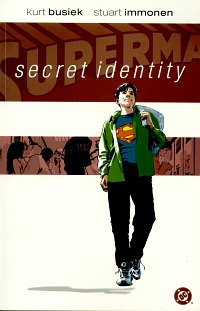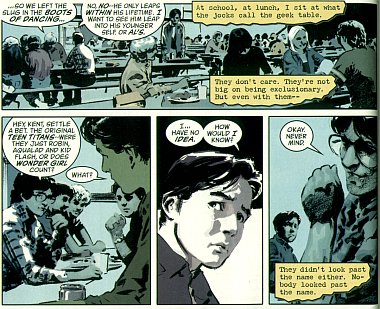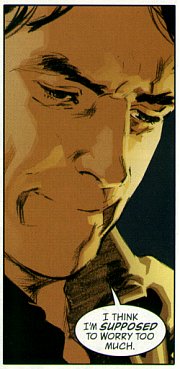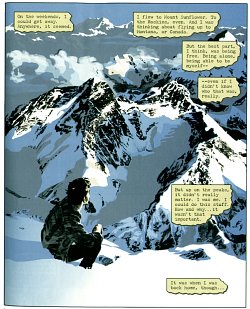Superman: Secret Identity

 One of the common dismissals of the superhero genre is that it’s too limited. It’s all about juvenile morality plays and adolescent power fantasies, and that’s all it’s good for. Kurt Busiek is one of the writers who thinks it’s useful for more than that, and Superman: Secret Identity is one effort prove that.
One of the common dismissals of the superhero genre is that it’s too limited. It’s all about juvenile morality plays and adolescent power fantasies, and that’s all it’s good for. Kurt Busiek is one of the writers who thinks it’s useful for more than that, and Superman: Secret Identity is one effort prove that.
As if to establish its fanboy-cred, Busiek’s introduction tells the story’s “secret origin”, explaining that it’s based on an old DC Comics Presents story about the Clark Kent of Earth-Prime. This was a boy who lived on our world, where Superman was a comic-book character, and a kid named “Clark Kent” was sure to be teased for it. But then he discovers that he does in fact have the power to bend steel bars in his bare hands, to change the course of mighty rivers, and so on, and goes on to meet his final fate in Crisis on Infinite Earths. This is the story that Busiek wanted to tell about that character, about what it would be like to actually become Superboy in the real world.
The book begins by focusing on the usual “secret identity” issues that come up for a super-powered teenager who wants to live a normal life. This isn’t exactly untilled ground, having been explored by some of the original adventures of Superboy, and a host of teen heroes since. The metaphor of an adolescent who feels like he doesn’t fit in anywhere has certainly been done before. But Busiek handles it very well. Having lived through adolescence with not just the feeling that I don’t fit in, but the knowledge that there was something about me that I have to keep secret (in my case, being gay), I can confirm that Busiek got that part of it very right.
 But he doesn’t stop there. Each of the four chapters of the book visits Clark Kent in a different period in his life, so the bipolar adolescent joy and angst of self-discovery only lasts for the first quarter of the book (titled “Smallville”). In the second chapter (”Metropolis”), the young adult Clark moves to the big city, and meets his own Lois (they’re set up on a date by friends who think it’d be funny), and struggles with the decision of whether to reveal this part of himself to her. In this context the “secret identity” is about the risks and potential pain of opening yourself up entirely to another person… or of not doing so. I’ve been faced with that issue myself, and Busiek understands it well.
But he doesn’t stop there. Each of the four chapters of the book visits Clark Kent in a different period in his life, so the bipolar adolescent joy and angst of self-discovery only lasts for the first quarter of the book (titled “Smallville”). In the second chapter (”Metropolis”), the young adult Clark moves to the big city, and meets his own Lois (they’re set up on a date by friends who think it’d be funny), and struggles with the decision of whether to reveal this part of himself to her. In this context the “secret identity” is about the risks and potential pain of opening yourself up entirely to another person… or of not doing so. I’ve been faced with that issue myself, and Busiek understands it well.
Chapter three (”Fortress”) explores Clark’s life as a grown-up with a family, and the conflict of keeping himself - and more importantly, them - safe from those who would seek to harm a hero of his abilities through those he loves. That’s angle is a fairly standard trope of the genre, explaining why so many superheroes bother with secret identities, but it’s frequently misapplied as if it explained why the heroes hide it even from their wives. Thankfully, Busiek doesn’t make that mistake. As a by-now-confirmed bachelor, I can’t relate as directly to Clark’s situation in this stage of his life, but Busiek paints a convincing portrait of a man’s concern for his family’s safety, and the lengths he’ll go to, to protect it.
 The final chapter (”Tomorrow”) shows us Clark in middle age, and then in his greying years. In this phase he finds himself on the other side of the “secret identity” coin, but more importantly (to me, at least) this chapter explores (super)powers in decline, as Clark - like anyone of a certain age or beyond - starts to feel his own mortality creeping up on him, oh so slowly robbing him of his strength and abilities. It’s more than just the “old = out of shape” comedic bits of The Incredibles, and I can clearly grasp what Busiek is trying to say here as well. If superpowers are a metaphor for adult independence in all those “adolescent power fantasies”, then they serve the same role here.
The final chapter (”Tomorrow”) shows us Clark in middle age, and then in his greying years. In this phase he finds himself on the other side of the “secret identity” coin, but more importantly (to me, at least) this chapter explores (super)powers in decline, as Clark - like anyone of a certain age or beyond - starts to feel his own mortality creeping up on him, oh so slowly robbing him of his strength and abilities. It’s more than just the “old = out of shape” comedic bits of The Incredibles, and I can clearly grasp what Busiek is trying to say here as well. If superpowers are a metaphor for adult independence in all those “adolescent power fantasies”, then they serve the same role here.
This may sound a bit melancholy, but I assure you that’s almost entirely coming from me, not the book. Secret Identity is a generally up-beat, hopeful story about a person who discovers amazing abilities within himself, and how he makes them a part of his life.
One aspect of the closing chapter that struck a chord with me was how things had changed for Clark in the years since he was in high school, making what had seemed such a necessary secret… no longer quite as big a deal. (To explain any further would be a spoiler, I think, so I’ll leave it at that.) I doubt this was Busiek’s intention, but that seemed to parallel my experience with my own high-school-era secret.
There are some flaws in the story. The way Clark’s parents just disappear from it seems a bit unlikely. Heck, even a non-communicative loner such as I goes to my parents when I’m in trouble. And I’d think that an author with Clark’s dislike for his already-famous and ridicule-inviting name would use a pen-name. But this is nit-picking.
 I haven’t said anything yet about Stuart Immonen’s art, which is a serious oversight. He has a subtle, naturalistic style that serves this material excellently. His Clark is a real, dynamic, expressive person, not a drawn-to-model-sheet hero in a costume. He ages recognisably from one chapter to the next, and not just through the usual shortcut clichés of giving him a haircut when he becomes an adult, and giving him more facial hair and less cranial hair when he gets older. Immonen does the whole job here, from layouts through colors, and he takes advantage of that level of control in a way that suits his style well. The color palette - nearly all tertiary colors, with hardly a primary color to be found (even Clark’s costume has the muted shades of Brandon Routh’s upcoming costume) - gets a little bit muddy from time to time, but gives it a distinctive, real-world look. Immonen also plays around - just a little, at the beginning of each chapter and a bit near the end - with the changing “look” of comics over the decades, effectively mimicking Joe Shuster, Wayne Boring, Curt Swan, and Rick Burchett.
I haven’t said anything yet about Stuart Immonen’s art, which is a serious oversight. He has a subtle, naturalistic style that serves this material excellently. His Clark is a real, dynamic, expressive person, not a drawn-to-model-sheet hero in a costume. He ages recognisably from one chapter to the next, and not just through the usual shortcut clichés of giving him a haircut when he becomes an adult, and giving him more facial hair and less cranial hair when he gets older. Immonen does the whole job here, from layouts through colors, and he takes advantage of that level of control in a way that suits his style well. The color palette - nearly all tertiary colors, with hardly a primary color to be found (even Clark’s costume has the muted shades of Brandon Routh’s upcoming costume) - gets a little bit muddy from time to time, but gives it a distinctive, real-world look. Immonen also plays around - just a little, at the beginning of each chapter and a bit near the end - with the changing “look” of comics over the decades, effectively mimicking Joe Shuster, Wayne Boring, Curt Swan, and Rick Burchett.
There’s no “mature readers” label on the cover, nor should there be, because there’s nothing in it that’s really inappropriate for anyone old enough to have enough money to buy it. But it’s definitely a story that will appeal to mature readers. It’s thoughtful and introspective, and encourages the reader to be a little introspective. (Not as introspective as Steven Seagal’s recent Superman graphic novel It’s a Bird, though.) But it’s still a fast-paced story (the leaps between chapters help) with more than a little tension and excitement. The story contains superheroics, but it’s not about superheroics, instead using them to look at the man performing them.
